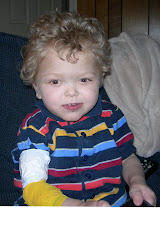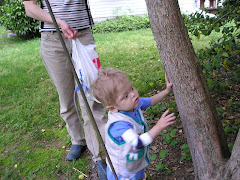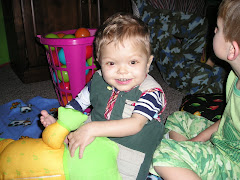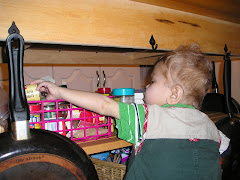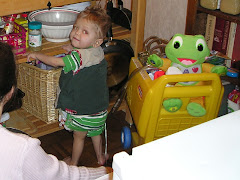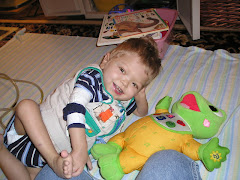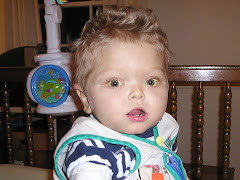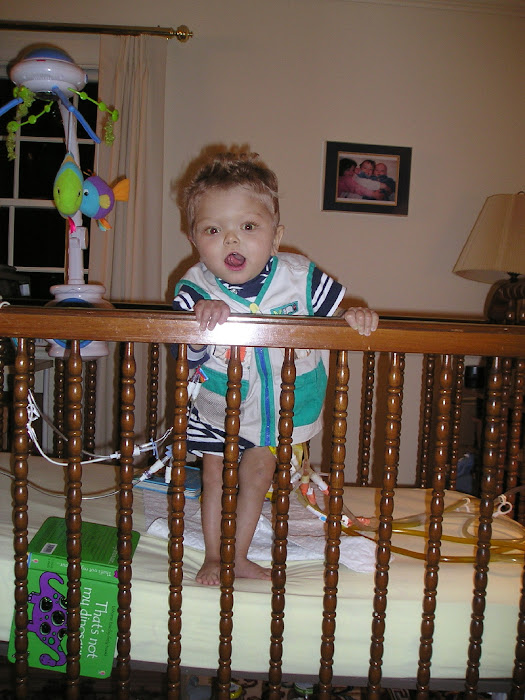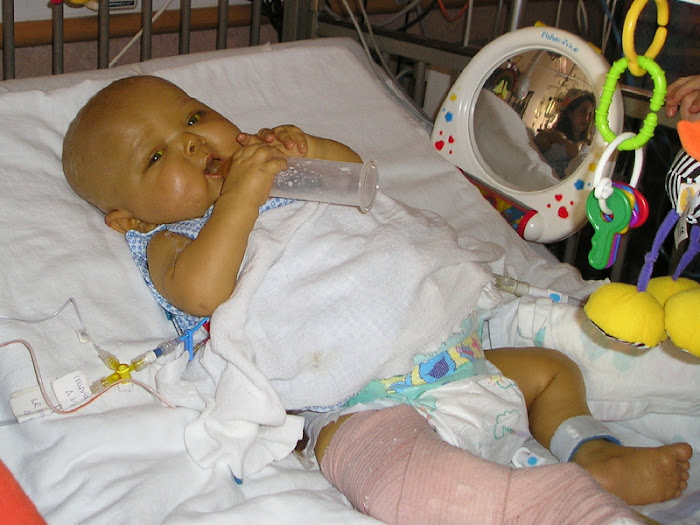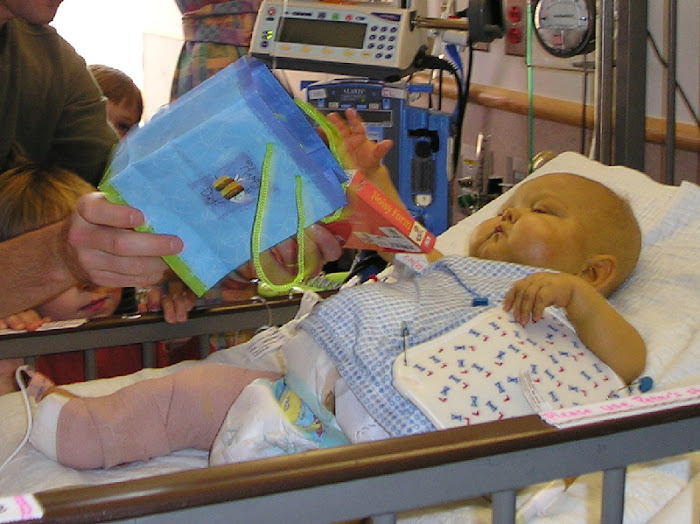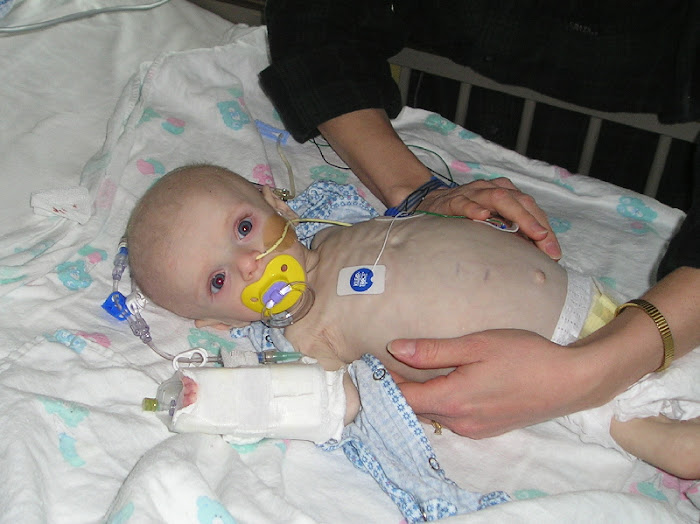While we were at CHOP two weeks ago inpatient, the GI doctor there felt that the best way for us to get Peter's bowel up and going is to surgically put it back together. That would give it the best shot at showing us how functional it is. Dr. Kamin has said the same. Sounds simple. Dr. Kim has told us that Peter's bowel may never be able to be surgically closed as of our last trip to Boston in February. However, Dr. Kim encouraged us to get another opinion, as someone else may see an option that he doesn't. So while we were at CHOP, Dr. Flake did come to see Peter and me. The bottom line is that he also feels Peter is a tremendous surgical risk and that his option is really only transplant at this time. Risks include: portal hypertension (bleeding risk during and after surgery, and possible poor healing from altered cirulation), increased coagulation times (bleeding risks again), ascites (poor healing and fragile bowel tissue), prior surgical scarring of the bowel (adhesions in the bowel that would be stronger than the bowel itself, lending the bowel to tearing when trying to separate the adhesions), as well as the facts that we don't know if the bowel actually works, and that we still may end up needing a liver tranpslant down the road if the liver truly isn't much better than it was. Finally, Peter has to heal from what Dr. Flake felt would be multiple risky operations. He said he has people with healthy bowel develop fistulas after bowel surgery and worries that Peter would only develop more fistulas with surgery. A transplant would give him a whole new bowel, new liver, and remove the portal hypertension because his portal vein and clot would leave with his liver and be replaced with the new liver and its circulatory veins and arteries.
Not the answers we were hoping for, and Dr. Flake apologized that he couldn't give us the non-transplant answer that we wanted. So we are planning to seek the advice of a third surgeon who works with Dr. Puder who is the Omegaven doctor at CHB. We would plan to see him the next time we are up in Boston. That will give us time for the TPN nutrition changes to kick in and maybe even to begin testing the bowel a bit more. If he also says there is no other option, then that is our answer. But he may see things differently, as he has for two other short-gut children that we are aware of. Dr. Kamin reminds us that Peter is doing things now that have not been done - kids as sick as Peter have either gone on to transplant or died, not acted better and better, and not improved by labs and examination. So he may still surprise us with the improved TPN nutrition and drop the ascites, may continue to lower the coagulation numbers (last INR was 1.3), and may have a healthier bowel with the improved nutrition. Portal hypertension may still be of concern with operating, or maybe there is something we can do to assist with that risk as well.
Everything has some big risks - surgery to put the bowel together, transplant and post-transplant living, staying on TPN, having portal hypertension, having a central line (the PICC line). Once we get our third opinion, then I guess we weigh the risks and try to choose to keep trying to rehab the bowel or to transplant. Or we may not have a choice... but we feel that we would be fine with that too. We have been praying for direction and patience while we wait to see which way his bowel and liver and surgical opinions go. We are always grateful for Peter's smiles and playfulness... which have been more abundant than ever. Maybe that is God's way of giving us patience - having Peter show us that he is content and patient, and we should be too.
Wednesday, April 30, 2008
Keeping us guessing
Peter had ANOTHER mystery illness with low-grade fever, nausea, abdominal tenderness, fluid gain, increased respiratations and heartrate, and grunting respirations. And again it was the weekend... at night. And then the idea struck that perhaps these mystery illnesses have something in common. Peter has not been ill in so long, and then three times in less than two months?! Looking back through notes there are two things that seem in common as possible causes - enteral flagyl or the more lengthy time spent with the G-tube clamped off. So, we stopped both, and Peter pulled right on out of the illness within 24 hours after stopping both things. On Monday's routine lab draw, his numbers all look good, except for the C-reactive protein (CRP) which went really high and is a marker of inflammation or infection, but is non-specific. We got cultures drawn from the PICC and urine (done at home, to our great relief), but he is still acting well since our Friday illness, so the CRP may mean he picked up a virus, or that the possible allergy also caused inflammation, or somthing else... but if he is acting well nothing to worry about, unless it keeps rising in subsequent labs.
The enteral flagyl was to treat bacterial overgrowth in his gut which is a common issue in kids that aren't eating. We will switch back to cipro again, every 3 weeks for a week via G-tube. He has tolerated that well in the past.
We will also hold off on clamping the G-tube again for another week or two until we feel certain Peter is not ill by labs and behavior and time. So, still no enteral feeds and now no clamping. Not making much progress in the enteral department this way, but it would be hard to decide if he is having intolerance to feeds or to clamping if we threw that into the picture and he started acting ill again.
He seems to be liking the extra protein and calories in the TPN. Weight is still down, but his energy is definitely up. He keeps wanting to walk with his "car" walker from room to room, pausing to look in the refrigerator, kitchen cabinets, and to smell almost every spice that we have... several times a day. And, he pauses to look at his reflection as he walks past the stove and the dishwasher, with a gigantic grin of well-deserved satisfaction.

Peter's walker, "car"

In the kitchen
The enteral flagyl was to treat bacterial overgrowth in his gut which is a common issue in kids that aren't eating. We will switch back to cipro again, every 3 weeks for a week via G-tube. He has tolerated that well in the past.
We will also hold off on clamping the G-tube again for another week or two until we feel certain Peter is not ill by labs and behavior and time. So, still no enteral feeds and now no clamping. Not making much progress in the enteral department this way, but it would be hard to decide if he is having intolerance to feeds or to clamping if we threw that into the picture and he started acting ill again.
He seems to be liking the extra protein and calories in the TPN. Weight is still down, but his energy is definitely up. He keeps wanting to walk with his "car" walker from room to room, pausing to look in the refrigerator, kitchen cabinets, and to smell almost every spice that we have... several times a day. And, he pauses to look at his reflection as he walks past the stove and the dishwasher, with a gigantic grin of well-deserved satisfaction.

Peter's walker, "car"

In the kitchen
Friday, April 18, 2008
In and out of CHOP again
We had another unexpected admission to CHOP last week. Peter was fussy, temp on/off, and then began vomiting. If you get a fever with a central line, it pretty much automatically means that you need to obtain blood cultures and begin antibiotics for at least 48 hours. If nothing grows out of the culture, antibiotics can be stopped. Last time Peter continued antibiotics without anything growing because it was possible he had a pocket of infected fluid. This time though, he had been exposed to a cold, strep throat, and a GI bug with vomiting. After nothing grew out of the cultures, he was taken off antibiotics and sent home, looking pretty good for a kid who three days before was vomiting and two days before slept almost the whole day and had started retaining fluid. Peter almost always retains fluid when he gets hit with a virus or bacterial infection.
The good that came out of the admission was that we had a very astute GI attending (the director of the GI dept) who saw beyond the current illness and began discussions with our Boston team about Peter's overall illness and progress. This has helped us in the reevaluation of his TPN nutrition, which always seems to be such a delicate balancing act. Peter's liver numbers are good enough that there has been some question if he is actually getting enough protein, even though by the books he is receiving a huge amount. We are going to go ahead and try making some big changes, increasing his protein and increasing his calories by quite a bit, which hopefully will boost his energy and reduce the ascities. We have our fingers crossed. It seems worth a try, and if Peter can't handle it, then we can always go back down on the protein. Dr. Kamin is in complete agreement, and I think is glad to have another GI who also feels that Peter may need more protein, whether "the books" say he is getting enough or not.
We also met with Peter's CHOP surgeon, Dr. Flake, and discussed Peter's surgical issues with him. That is for another post, but the meeting was sincere and was actually suggested by Dr. Kim the last time we were in Boston. So, I must say, that as much as we always dislike an unexpected hospitalization, especially if Peter is acting ill, the admission gave us the opportunity to discover and address some needed tweaking in Peter's care.
The good that came out of the admission was that we had a very astute GI attending (the director of the GI dept) who saw beyond the current illness and began discussions with our Boston team about Peter's overall illness and progress. This has helped us in the reevaluation of his TPN nutrition, which always seems to be such a delicate balancing act. Peter's liver numbers are good enough that there has been some question if he is actually getting enough protein, even though by the books he is receiving a huge amount. We are going to go ahead and try making some big changes, increasing his protein and increasing his calories by quite a bit, which hopefully will boost his energy and reduce the ascities. We have our fingers crossed. It seems worth a try, and if Peter can't handle it, then we can always go back down on the protein. Dr. Kamin is in complete agreement, and I think is glad to have another GI who also feels that Peter may need more protein, whether "the books" say he is getting enough or not.
We also met with Peter's CHOP surgeon, Dr. Flake, and discussed Peter's surgical issues with him. That is for another post, but the meeting was sincere and was actually suggested by Dr. Kim the last time we were in Boston. So, I must say, that as much as we always dislike an unexpected hospitalization, especially if Peter is acting ill, the admission gave us the opportunity to discover and address some needed tweaking in Peter's care.
Wednesday, April 9, 2008
Insurance fun
So, the next time your insurance company cheerfully tells you that they have approved a service for you, find out if they are applying it to your out-of-network lifetime maximum. It has come to my attention recently that several of Peter's services have been approved this way. Things that should be covered in-network should not be penalized as out-of-network if there was no one available to provide the service in-network. But that is not how the insurance company has billed it, nor is it how it was presented to me. I was just told the services were approved... and so I relaxed and we cruised along getting Peter the services needed. So now our lifetime out-of-network max is halfway met now, and the one justifiable out-of-network provider that we need every last out-of-network dollar for is Children's Hospital Boston.
"Well, you can still use unlimited in-network providers."
"Can you tell me the breakdown of just where all of these out-of-network costs are coming from?"
"Well, if you access the website and pull up your claim..."
"There are over 250 claims! AND there is NO indication of which ones you have paid in-network vs out-of-network. AND everytime I try to ask someone if this place or that provider are in or out of network I get a different answer! ... If my son needs a transplant at the out-of-network provider, is it still covered if we exhaust out-of-network benefits?"
"I can't tell you that it is covered, but I can tell you that since there is no one in network who does this type of transplant that you would be approved to have it done out-of-network."
"So it IS covered?"
"Well, I can't say that it is, but let's just say that since there isn't anyone in-network then you would have to go out-of-network, and transplant is covered. Do you catch what I am trying to say to you? In other words, I can't tell you it is definitely covered, but it is approved. And follow up services would be approved too since it is transplant and no one in network does that type of transplant."
So, is it me, or does this insurance-talk make no sense at all? I still can't figure out if Peter is covered for transplant if we blow through all of the out-of-network monies or not. And that was the case manager's explanation!! I'm not pushing for socialized medicine, just want straight, consistent answers and fair processing of Peter's bills. It is amazing how so many people in big companies can forget about being human beings and just treat you like a number. What if I were your sister or your mother or your daughter and asked you that same question? Well, enough ranting for now. There are more calls to make tomorrow.
"Well, you can still use unlimited in-network providers."
"Can you tell me the breakdown of just where all of these out-of-network costs are coming from?"
"Well, if you access the website and pull up your claim..."
"There are over 250 claims! AND there is NO indication of which ones you have paid in-network vs out-of-network. AND everytime I try to ask someone if this place or that provider are in or out of network I get a different answer! ... If my son needs a transplant at the out-of-network provider, is it still covered if we exhaust out-of-network benefits?"
"I can't tell you that it is covered, but I can tell you that since there is no one in network who does this type of transplant that you would be approved to have it done out-of-network."
"So it IS covered?"
"Well, I can't say that it is, but let's just say that since there isn't anyone in-network then you would have to go out-of-network, and transplant is covered. Do you catch what I am trying to say to you? In other words, I can't tell you it is definitely covered, but it is approved. And follow up services would be approved too since it is transplant and no one in network does that type of transplant."
So, is it me, or does this insurance-talk make no sense at all? I still can't figure out if Peter is covered for transplant if we blow through all of the out-of-network monies or not. And that was the case manager's explanation!! I'm not pushing for socialized medicine, just want straight, consistent answers and fair processing of Peter's bills. It is amazing how so many people in big companies can forget about being human beings and just treat you like a number. What if I were your sister or your mother or your daughter and asked you that same question? Well, enough ranting for now. There are more calls to make tomorrow.
Ultrasound results
Dr. Kamin reviewed the ultrasounds from CHOP and the good news is that there is NOT air in the liver as was initially feared. Yea!!
That being said, to be extra careful, we are going to wait at least one more week before restarting feeds, as to not blur a possibility of an unfound lingering infection rearing its head now that he is off antibiotics. Peter has had no feeds since he went into CHOP on March 14. As of yesterday though, we are allowed to give him fruit in a mesh bag again. He has been having water all along.
Peter's CRP is back down to normal. He ended antibiotics 8 days ago and is still afebrile and labs support that he is as good as he was before the emergency hospitalization. We are thinking now that maybe he did have a bowel obstruction... maybe. A piece of the wafer from the fistula appliance was found in the ileostomy appliance on day two of our admission. Possibly it balled up inside and caused a brief blockage inside his gut which is still quite unaccustomed to anything more than liquid at this point. The stricture towards the end of the ileostomy would be a likely place for something to back up. The other thing it may be though is a sort of intestinal angina, where the intestine cramps up as blood flow tries to increase for digestion but can't. The result is similar to heart angina, where a diseased heart tries to increase blood flow for an increased activity level but physically can't. I don't think we'll have an answer to this though until we retry the bowel with formula again.
We are thinking more about transplant these days... preparing for the possiblity that this bowel just doesn't work and/or this liver just can't go enough of the distance to avoid transplant. Peter still has a portal vein clot that will never go away, and only a portion of liver left from the initial surgeries, that is damaged, but spared enough by Omegaven to get our son as strong as he is now and to keep him home for over a year now. The ascites is still ever present, the spleen remains large... mainly thought to be from the portal hypertension due to the portal vein clot, vs from TPN cholestasis. The chances of Peter's bowel working well enough to get off TPN are a very long shot. This is not to say that we are done trying to use this gut yet... if the bowel works, we will praise the miracle that it will be. But if we still are getting nowhere in the next few weeks to months, then we can still say that we tried all that we could, and the new chapters of Peter's life will then contain the words "transplant" instead of "short gut."
That being said, to be extra careful, we are going to wait at least one more week before restarting feeds, as to not blur a possibility of an unfound lingering infection rearing its head now that he is off antibiotics. Peter has had no feeds since he went into CHOP on March 14. As of yesterday though, we are allowed to give him fruit in a mesh bag again. He has been having water all along.
Peter's CRP is back down to normal. He ended antibiotics 8 days ago and is still afebrile and labs support that he is as good as he was before the emergency hospitalization. We are thinking now that maybe he did have a bowel obstruction... maybe. A piece of the wafer from the fistula appliance was found in the ileostomy appliance on day two of our admission. Possibly it balled up inside and caused a brief blockage inside his gut which is still quite unaccustomed to anything more than liquid at this point. The stricture towards the end of the ileostomy would be a likely place for something to back up. The other thing it may be though is a sort of intestinal angina, where the intestine cramps up as blood flow tries to increase for digestion but can't. The result is similar to heart angina, where a diseased heart tries to increase blood flow for an increased activity level but physically can't. I don't think we'll have an answer to this though until we retry the bowel with formula again.
We are thinking more about transplant these days... preparing for the possiblity that this bowel just doesn't work and/or this liver just can't go enough of the distance to avoid transplant. Peter still has a portal vein clot that will never go away, and only a portion of liver left from the initial surgeries, that is damaged, but spared enough by Omegaven to get our son as strong as he is now and to keep him home for over a year now. The ascites is still ever present, the spleen remains large... mainly thought to be from the portal hypertension due to the portal vein clot, vs from TPN cholestasis. The chances of Peter's bowel working well enough to get off TPN are a very long shot. This is not to say that we are done trying to use this gut yet... if the bowel works, we will praise the miracle that it will be. But if we still are getting nowhere in the next few weeks to months, then we can still say that we tried all that we could, and the new chapters of Peter's life will then contain the words "transplant" instead of "short gut."
Subscribe to:
Posts (Atom)



